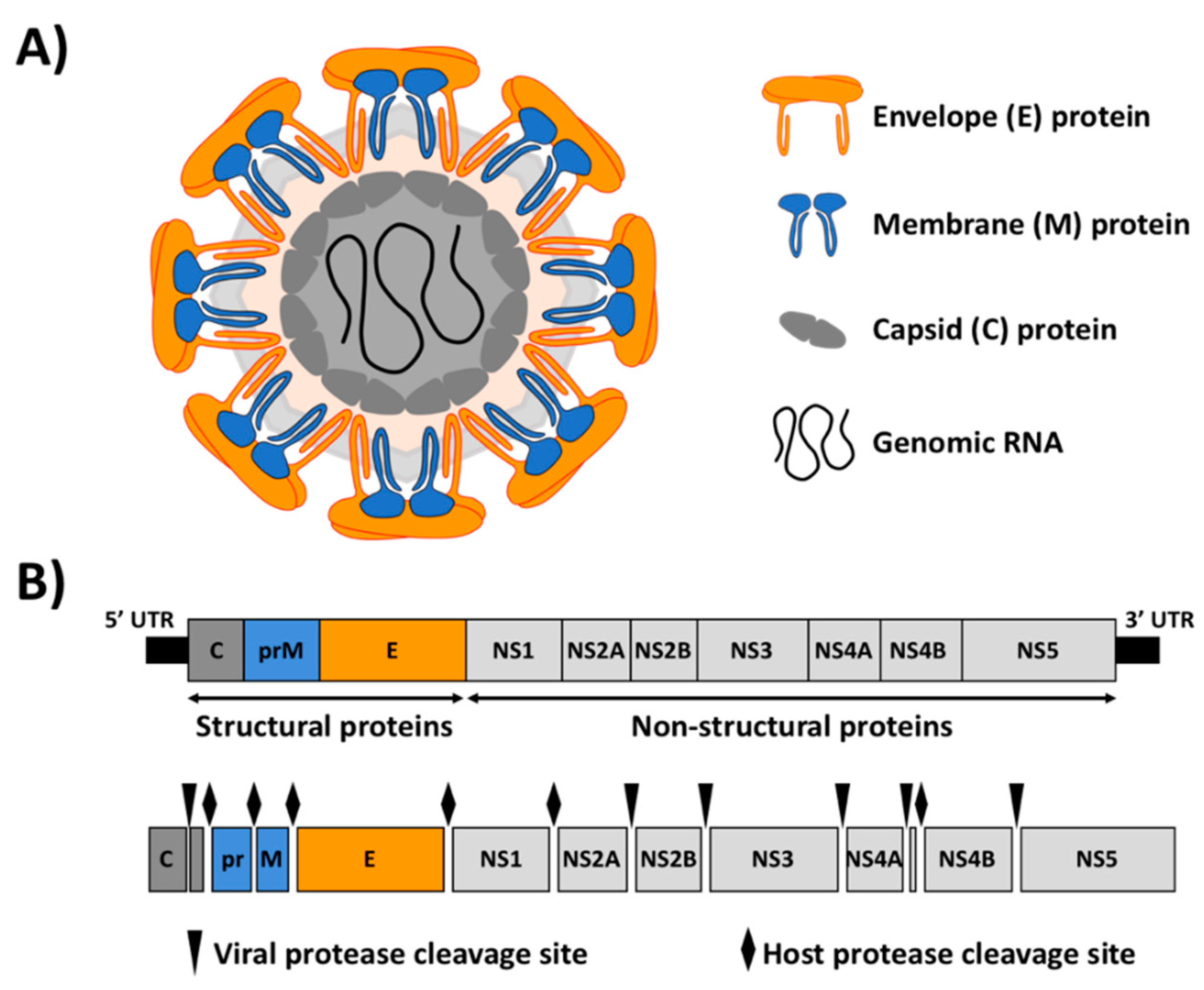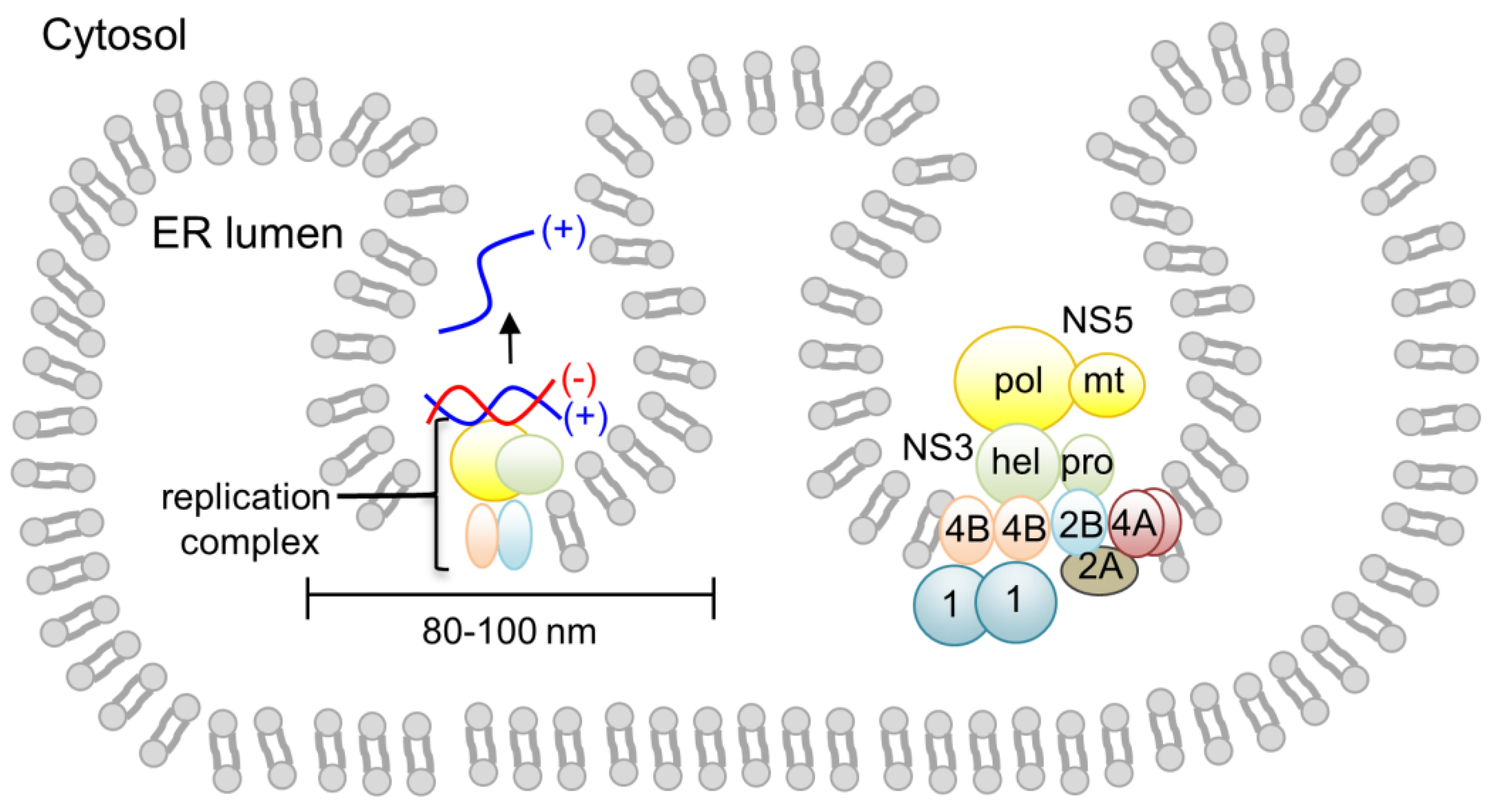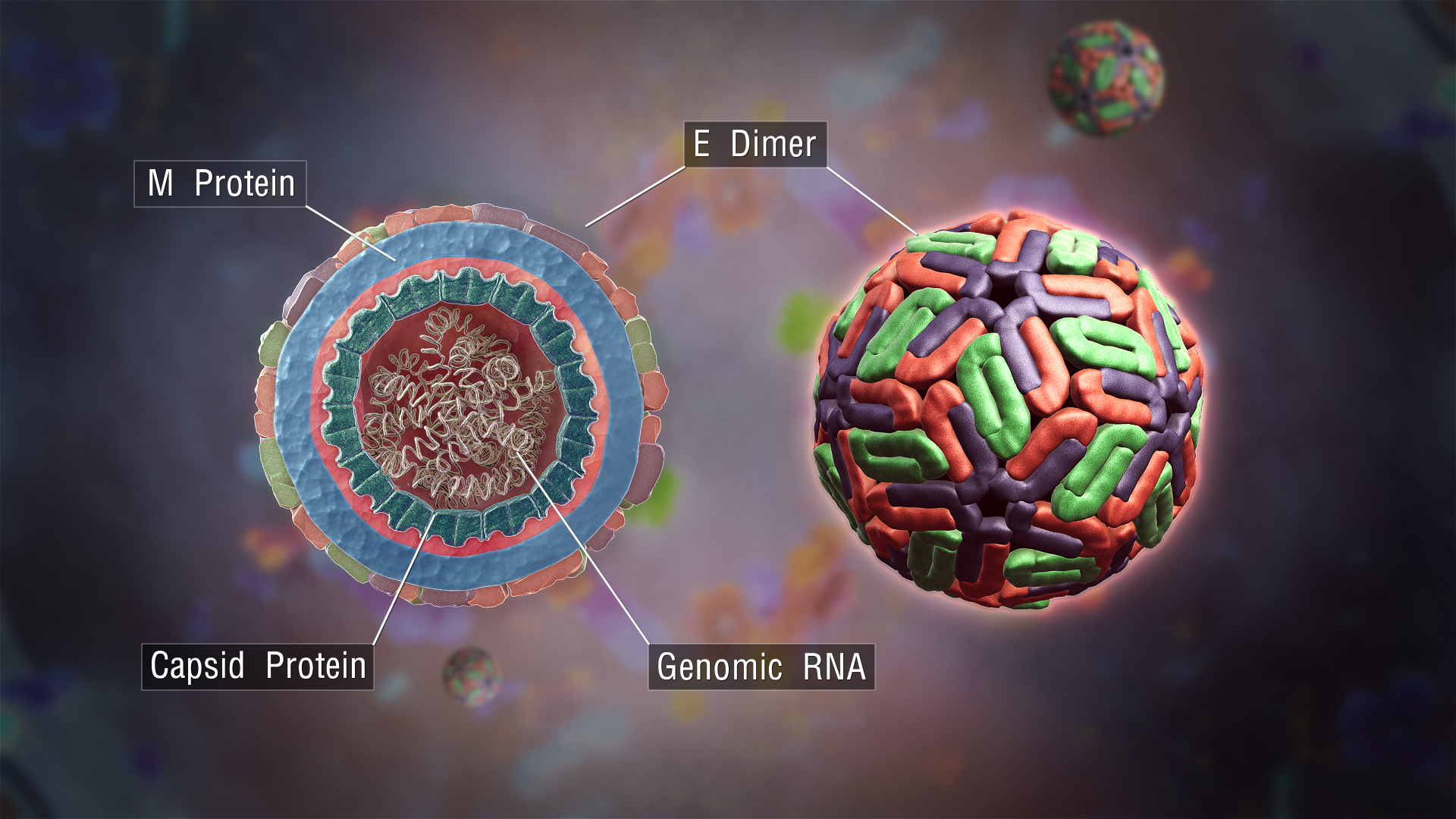|
Flavivirid
''Flaviviridae'' is a family of enveloped positive-strand RNA viruses which mainly infect mammals and birds. They are primarily spread through arthropod vectors (mainly ticks and mosquitoes). The family gets its name from the yellow fever virus; ''flavus'' is Latin for "yellow", and yellow fever in turn was named because of its propensity to cause jaundice in victims. There are 89 species in the family divided among four genera. Diseases associated with the group include: hepatitis (hepaciviruses), hemorrhagic syndromes, fatal mucosal disease (pestiviruses), hemorrhagic fever, encephalitis, and the birth defect microcephaly (flaviviruses). Structure Virus particles are enveloped and spherical with icosahedral-like geometries that have pseudo T=3 symmetry. They are about 40–60 nm in diameter. Genome Members of the family ''Flaviviridae'' have monopartite, linear, single-stranded RNA genomes of positive polarity, and 9.6 to 12.3 kilobase in total length. The 5'-termini ... [...More Info...] [...Related Items...] OR: [Wikipedia] [Google] [Baidu] |
Hepacivirus
''Hepacivirus'' is a genus of positive-strand RNA viruses in the family ''Flaviviridae''. The hepatitis C virus (HCV), in species ''Hepacivirus C'', infects humans and is associated with hepatitis and hepatocellular carcinoma. There are fourteen species in the genus which infect a range of other vertebrate. History Hepatitis C virus (HCV), which is the causative agent of hepatitis C in humans, and a member of the species ''Hepacivirus C'', was discovered in 1989. Seven genotypes (1–7) and eighty-six subtypes (1a, 1b etc.) of hepatitis C virus have been named. GBV-B virus (also known as GB virus B) discovered in 1995 is capable of infecting New World monkeys, in particular tamarins. Like HCV it is transmitted by the blood-borne route and similar to HCV it is associated with the viral hepatitis. However GBV-B has never been identified in wild animals and its natural host is not known. Structure Viruses in the genus ''Hepacivirus'' are enveloped and have spherical icosahedral-li ... [...More Info...] [...Related Items...] OR: [Wikipedia] [Google] [Baidu] |
Flavivirus
''Flavivirus'' is a genus of positive-strand RNA viruses in the family ''Flaviviridae''. The genus includes the West Nile virus, dengue virus, tick-borne encephalitis virus, yellow fever virus, Zika virus and several other viruses which may cause encephalitis, as well as insect-specific flaviviruses (ISFs) such as cell fusing agent virus (CFAV), Palm Creek virus (PCV), and Parramatta River virus (PaRV). While dual-host flaviviruses can infect vertebrates as well as arthropods, insect-specific flaviviruses are restricted to their competent arthropods. The means by which flaviviruses establish persistent infection in their competent vectors and cause disease in humans depends upon several virus-host interactions, including the intricate interplay between flavivirus-encoded immune antagonists and the host antiviral innate immune effector molecules. Flaviviruses are named for the yellow fever virus; the word ''flavus'' means 'yellow' in Latin, and yellow fever in turn is named from i ... [...More Info...] [...Related Items...] OR: [Wikipedia] [Google] [Baidu] |
Flavivirus
''Flavivirus'' is a genus of positive-strand RNA viruses in the family ''Flaviviridae''. The genus includes the West Nile virus, dengue virus, tick-borne encephalitis virus, yellow fever virus, Zika virus and several other viruses which may cause encephalitis, as well as insect-specific flaviviruses (ISFs) such as cell fusing agent virus (CFAV), Palm Creek virus (PCV), and Parramatta River virus (PaRV). While dual-host flaviviruses can infect vertebrates as well as arthropods, insect-specific flaviviruses are restricted to their competent arthropods. The means by which flaviviruses establish persistent infection in their competent vectors and cause disease in humans depends upon several virus-host interactions, including the intricate interplay between flavivirus-encoded immune antagonists and the host antiviral innate immune effector molecules. Flaviviruses are named for the yellow fever virus; the word ''flavus'' means 'yellow' in Latin, and yellow fever in turn is named from i ... [...More Info...] [...Related Items...] OR: [Wikipedia] [Google] [Baidu] |
Hepacivirus
''Hepacivirus'' is a genus of positive-strand RNA viruses in the family ''Flaviviridae''. The hepatitis C virus (HCV), in species ''Hepacivirus C'', infects humans and is associated with hepatitis and hepatocellular carcinoma. There are fourteen species in the genus which infect a range of other vertebrate. History Hepatitis C virus (HCV), which is the causative agent of hepatitis C in humans, and a member of the species ''Hepacivirus C'', was discovered in 1989. Seven genotypes (1–7) and eighty-six subtypes (1a, 1b etc.) of hepatitis C virus have been named. GBV-B virus (also known as GB virus B) discovered in 1995 is capable of infecting New World monkeys, in particular tamarins. Like HCV it is transmitted by the blood-borne route and similar to HCV it is associated with the viral hepatitis. However GBV-B has never been identified in wild animals and its natural host is not known. Structure Viruses in the genus ''Hepacivirus'' are enveloped and have spherical icosahedral-li ... [...More Info...] [...Related Items...] OR: [Wikipedia] [Google] [Baidu] |
Pegivirus
''Pegivirus'' is the approved name for a genus of single positive-stranded RNA viruses in the family ''Flaviviridae''. The name is a derived one: "Pe" stands for "persistent" and "g" is a reference to Hepatitis G, a former name of the ''C'' species. Taxonomy Eleven named species are within the genus ''Pegivirus''. Isolates belonging to the species ''Pegivirus C'' are monophyletic and show 50% nucleotide (>55% amino acid) divergence from other members of this genus. Pegiviruses assigned to this species (''Pegivirus A'') originate from primate host species (humans, chimpanzees and several New World monkey species). The sequence U22303 has been assigned as the type member of the species, as this was the first pegivirus to be described for this species. Terminology to describe viruses with different hosts has not been approved by the International Committee on Taxonomy of Viruses; however, ''Pegivirus A'' viruses have been called HPgV for human pegivirus, SPgV for new world simia ... [...More Info...] [...Related Items...] OR: [Wikipedia] [Google] [Baidu] |
Dengue Virus
''Dengue virus'' (DENV) is the cause of dengue fever. It is a mosquito-borne, single positive-stranded RNA virus of the family ''Flaviviridae''; genus ''Flavivirus''. Four serotypes of the virus have been found, a reported fifth has yet to be confirmed,Dwivedi, V. D., Tripathi, I. P., Tripathi, R. C., Bharadwaj, S., & Mishra, S. K. (2017). Genomics, proteomics and evolution of ''Dengue virus''. Briefings in functional genomics.16(4): 217–227, https://doi.org/10.1093/bfgp/elw040 all of which can cause the full spectrum of disease. Nevertheless, scientists' understanding of dengue virus may be simplistic as, rather than distinct antigenic groups, a ''continuum'' appears to exist. This same study identified 47 strains of ''dengue virus''. Additionally, coinfection with and lack of rapid tests for ''zika virus'' and ''chikungunya'' complicate matters in real-world infections. ''Dengue virus'' has increased dramatically within the last 20 years, becoming one of the worst mosquito- ... [...More Info...] [...Related Items...] OR: [Wikipedia] [Google] [Baidu] |
Clathrin
Clathrin is a protein that plays a major role in the formation of coated vesicles. Clathrin was first isolated and named by Barbara Pearse in 1976. It forms a triskelion shape composed of three clathrin heavy chains and three light chains. When the triskelia interact they form a polyhedral lattice that surrounds the vesicle, hence the protein's name, which is derived from the Latin ''clathrum'' meaning lattice. Coat-proteins, like clathrin, are used to build small vesicles in order to transport molecules within cells. The endocytosis and exocytosis of vesicles allows cells to communicate, to transfer nutrients, to import signaling receptors, to mediate an immune response after sampling the extracellular world, and to clean up the cell debris left by tissue inflammation. The endocytic pathway can be hijacked by viruses and other pathogens in order to gain entry to the cell during infection. Structure The clathrin triskelion is composed of three clathrin heavy chains inter ... [...More Info...] [...Related Items...] OR: [Wikipedia] [Google] [Baidu] |
Nucleotide
Nucleotides are organic molecules consisting of a nucleoside and a phosphate. They serve as monomeric units of the nucleic acid polymers – deoxyribonucleic acid (DNA) and ribonucleic acid (RNA), both of which are essential biomolecules within all life-forms on Earth. Nucleotides are obtained in the diet and are also synthesized from common nutrients by the liver. Nucleotides are composed of three subunit molecules: a nucleobase, a five-carbon sugar (ribose or deoxyribose), and a phosphate group consisting of one to three phosphates. The four nucleobases in DNA are guanine, adenine, cytosine and thymine; in RNA, uracil is used in place of thymine. Nucleotides also play a central role in metabolism at a fundamental, cellular level. They provide chemical energy—in the form of the nucleoside triphosphates, adenosine triphosphate (ATP), guanosine triphosphate (GTP), cytidine triphosphate (CTP) and uridine triphosphate (UTP)—throughout the cell for the many cellular func ... [...More Info...] [...Related Items...] OR: [Wikipedia] [Google] [Baidu] |
Bovine Viral Diarrhea
Bovine viral diarrhea (BVD), bovine viral diarrhoea (UK English) or mucosal disease, and previously referred to as bovine virus diarrhea (BVD), is an economically significant disease of cattle that is found in the majority of countries throughout the world. Worldwide reviews of the economically assessed production losses and intervention programs (e.g. eradication programs, vaccination strategies and biosecurity measures) incurred by BVD infection have been published. The causative agent, bovine viral diarrhea virus (BVDV), is a member of the genus ''Pestivirus'' of the family Flaviviridae. BVD infection results in a wide variety of clinical signs, due to its immunosuppressive effects, as well as having a direct effect on respiratory disease and fertility. In addition, BVD infection of a susceptible dam during a certain period of gestation can result in the production of a persistently infected (PI) fetus. PI animals recognise intra-cellular BVD viral particles as ‘self’ and ... [...More Info...] [...Related Items...] OR: [Wikipedia] [Google] [Baidu] |
Genomes
In the fields of molecular biology and genetics, a genome is all the genetic information of an organism. It consists of nucleotide sequences of DNA (or RNA in RNA viruses). The nuclear genome includes protein-coding genes and non-coding genes, other functional regions of the genome such as regulatory sequences (see non-coding DNA), and often a substantial fraction of 'junk' DNA with no evident function. Almost all eukaryotes have mitochondria and a small mitochondrial genome. Algae and plants also contain chloroplasts with a chloroplast genome. The study of the genome is called genomics. The genomes of many organisms have been sequenced and various regions have been annotated. The International Human Genome Project reported the sequence of the genome for ''Homo sapiens'' in 200The Human Genome Project although the initial "finished" sequence was missing 8% of the genome consisting mostly of repetitive sequences. With advancements in technology that could handle sequencing ... [...More Info...] [...Related Items...] OR: [Wikipedia] [Google] [Baidu] |
Nanometer
330px, Different lengths as in respect to the molecular scale. The nanometre (international spelling as used by the International Bureau of Weights and Measures; SI symbol: nm) or nanometer (American and British English spelling differences#-re, -er, American spelling) is a units of measurement, unit of length in the International System of Units (SI), equal to one billionth (short scale) of a metre () and to 1000 picometres. One nanometre can be expressed in scientific notation as , and as metres. History The nanometre was formerly known as the millimicrometre – or, more commonly, the millimicron for short – since it is of a micron (micrometre), and was often denoted by the symbol mμ or (more rarely and confusingly, since it logically should refer to a ''millionth'' of a micron) as μμ. Etymology The name combines the SI prefix ''nano-'' (from the Ancient Greek , ', "dwarf") with the parent unit name ''metre'' (from Greek , ', "unit of measurement"). ... [...More Info...] [...Related Items...] OR: [Wikipedia] [Google] [Baidu] |







